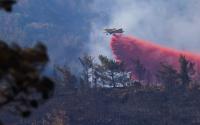Published on Saturday, January 1, 2005 by the Inter Press ServiceRanjit Devraj
Tsunamis and other natural disasters are posing a bigger challenge than pesky green activists to India's secretive nuclear power and research facilities on the coast of southern Tamil Nadu state, which accounted for 5,000 of the more than 50,000 deaths from this week's quakes and killer waves in Asia.
The worst casualties among the tens of thousands who died around the shores of countries around the Bay of Bengal have been in Sri Lanka, which is separated from Tamil Nadu by the narrow Palk Straits and where government sources now say as many as 25,000 people may have perished.
Authorities at India's secretive Department of Atomic Energy (DAE) have been quick to assert that the atomic facilities at Kalpakkam, 80 kilometers from Chennai, the state capital, were safe. On Tuesday, they allowed a group of journalists to inspect the installations to dispel widespread fears of radiation leakage.
On Monday night, the plant's director S K Jain said the plant had been shut down following flooding of the pump house that controls the flow of sea water used to cool the power plant. He added that a perimeter wall around a controversial Fast Breeder Reactor (FRB) being built at the site had collapsed.
Although the Kalpakkam facility escaped major damage, the fact that 30 inmates of the plant's residential complex nearby died and that several of them were technical personnel or atomic scientists was proof enough that planners never seriously considered the possibility of a tsunami striking the Tamil Nadu coast.
The residential complex has now been evacuated of its 1,500 families. No one is venturing to say when the 440-megawatt atomic power plant will be functional again or when work can resume on the controversial fast breeder reactor.
A bigger Russian-aided nuclear power complex that uses sea water for cooling is coming up fast at Koodankulam, 900 km south of Chennai and close to Kanyakumari, the southernmost tip of the Indian peninsula that was severely devastated by the tsunami that in some places reached 10 meters high.
Long before the tsunami struck, the secret workings of the Kalpakkam and Koodankulam facilities have been the subject of protests by local citizens and groups opposed to nuclear power -- most notably the People's Movement Against Nuclear Energy and South Asians Against Nukes (SAAN), an informal information platform for activists and scholars concerned about the nuclearization of South Asia.
The DAE has justified the allegations of the green activists by extending secrecy to serious radiation leaks that have endangered public safety in the recent past.
In March 1999 when there was a leak of heavy water at Kalpakkam, the Atomic Energy Regulatory Board (AERB), another wing of Indian nukedom, dismissed the incident by saying that "the release to the environment is maintained well within the limits specified by the AERB."
Another leak that affected workers at the Kalpakkam Reprocessing Plant in January 2003 was met with complete silence, but after persistent media reports and pressure from eminent scientists and public persons the DAE acknowledged the accident six months after the event.
Some of the installations at Kalpakkam are outside the reach of even the AERB or indeed any authority because they carry a strategic tag. These include the controversial fast breeder reactor (FBR) which involves the handling of large amounts of plutonium which can be used in nuclear warheads.
''The DAE must adopt an enlightened policy of keeping the public informed at all times about safety aspects of its installations,'' said M R Sreenivasan, one of India's leading nuclear scientists and former chairman of the Atomic Energy Commission, commenting on the Kalpakkam leaks and attempts to hide them.
The PMANE has mounted protests and seminars - including at the World Social Forum (WSF) in Mumbai in January 2004 - against fast breeder reactors which according to its convener S P Udayakumar is ''being promoted in this country by a dangerous combination of career-minded scientists and facilitated by secrecy laws that shroud the Department of Atomic Energy (DAE)".
FBRs have been built and operated in the United States, France and Japan but were phased out for a variety of reasons, but most especially because of accidents, such as the one at Monju in Japan in 1995 and the European reactor Super Phenix in France in 1987.
Germany built an experimental FBR reactor at Kalkar in 1991, but never put it into operation because of safety concerns. FBRs use liquid sodium coolant, but the metal reacts explosively when it comes into touch with water, as what happened at Monju.
Risky as the FBR project is, the PMANE and other anti-nuclear groups have been concentrating their energies on the bigger coastal project at Koodankulam, which is being built at a cost of five billion U.S. dollars although the area is known to seismically active.
''We have been trying to assert our right to know the impacts of this anti-people project on us and our children's health, safety and the environment but even elected civil and political societies are being kept in the dark by the DAE,'' said Udayakumar.
The DAE is intent on producing 4,000 megawatts of power at Koodankulam using four Russian reactors.
Two of these have already been supplied under an agreement signed in 1988, while the Soviet Union was still in existence and despite opposition from the U.S. government and from the Nuclear Suppliers Group (NSG) - also called the London Group because it first met in London in 1975 as a reaction to India exploding a nuclear device in the previous year.
Since 2002, the Russians have developed cold feet over the project, the actual site of which was shifted by the DAE without consulting them. Earlier, possibly under pressure from the NSG, Moscow announced its inability to supply two more reactors that were to make a complement of four reactors at the Koodankulam atomic energy plant.
Meanwhile, local bodies and religious groups have been regularly recording protests against the Koodankulam project.
The latest of these was on Oct. 30, when Amritajnana Tapaswini, the head of the well-regarded Santhigiri Ashram that maintains an ayurvedic and spiritual center, nearby insisted on leading a delegation into the high-security site to meet S K Agrawal, the project director, and warn him of possible dangers.
''You may be building this project at great cost in the name of humanity and using high technology, but it is well to remember that there are far higher forces in the world that you do not understand,'' she warned Agrawal.
Her remarks are now being seen as a premonition of the Dec. 26 tsunami that Indian scientists had been convinced would never strike the coasts of Tamil Nadu.
http://www.commondreams.org/cgi-bin/print.cgi?file=/headlines05/0101-01.htm






